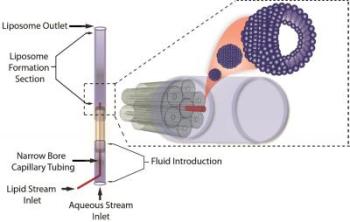When the English author Sir Francis Bacon wrote "The world's a bubble" in 1629, it's a safe bet he wasn't thinking about microfluidics. However, for a research team led by scientists at the National Institute of Standards and Technology (NIST), Bacon's words could not be truer.
Since 2004, their world has revolved around the development of increasingly sophisticated microfluidic devices to produce liquid-filled "bubbles" called liposomes for potential use as vehicles to deliver drugs directly to cancers and other diseased cells within the body.
 This is a schematic of the NIST/University of Maryland 3-D microfluidic hydrodynamic focusing device for manufacturing vesicles known as liposomes. Phospholipids dissolved in alcohol flowing through the center capillary (red) mix with a water-based buffer solution added through the six surrounding tubes. Liposomes are created downstream from the convergence point. Credit: NIST
This is a schematic of the NIST/University of Maryland 3-D microfluidic hydrodynamic focusing device for manufacturing vesicles known as liposomes. Phospholipids dissolved in alcohol flowing through the center capillary (red) mix with a water-based buffer solution added through the six surrounding tubes. Liposomes are created downstream from the convergence point. Credit: NIST
Liposomes are spheres made of a double layer of phospholipids, the fat complexes that are the building blocks for animal cell membranes. They resemble simple cells with the "guts" removed. Widespread application of manufactured liposomes as artificial drug carriers has been hindered by a number of limiting factors such as inconsistency in size, structural instability and high production costs.
In a new article in the journal Lab on a Chip,* the team from NIST and the University of Maryland (UM) describes a new approach for overcoming these obstacles. The group's novel system is made up of bundled capillary tubes, costs less than a $1 to make and requires no special fabrication technology or expertise, yet consistently yields large quantities of uniform and sturdy vesicles.
Previous NIST/UM microfluidic liposome-generating devices were two-dimensional designs incorporating tiny channels etched into a silicon wafer with the same techniques used for making integrated circuits. Phospholipid molecules dissolved in isopropyl alcohol were fed via a central inlet channel into a "mixer" channel and focused into a fluid jet by a water-based solution added through two side channels. The components blended together as they mixed at the interfaces of the flowing fluid streams, directing the phospholipid molecules to self-assemble into nanoscale vesicles of controlled size.
In the latest NIST/UM advance, the planar structure has been replaced by a three-dimensional microfluidic device. The new liposome generator consists of a 3-millimeter-diameter glass cylinder containing a bundle of seven tiny glass capillary tubes—each a millimeter across, or about the diameter of a pinhead—with one in the center and six surrounding it. A micro-sized plastic capillary (about 500 micrometers in diameter, or the length of an amoeba) is fed through the center tube and extended just beyond the end of the capillary bundle. All of the materials are commercially available at pennies per unit.
The water-based solution (known as PBS) flows through the outer six capillaries while the center channel carries the phospholipid dissolved in alcohol (in production, the PBS would carry a drug or other cargo for the vesicles). A standard glass pipette attached to the end of the microfluidic device improves mixing by concentrating the ratio of water to lipid/alcohol.
"With our 3D capillary device, we can increase production of high-quality liposomes threefold from what our 2D planar system can do in the same amount of time," says NIST research chemical engineer Wyatt Vreeland, one of the authors on the Lab on a Chip paper.
*R. Hood, D. DeVoe, J. Atencia, W. Vreeland and D. Omiatek. A Facile Route to the Synthesis of Monodisperse Nanoscale Liposomes Using 3D Microfluidic Hydrodynamic Focusing in a Concentric Capillary Array. Lab on a Chip, May 2014. DOI:10.1039/C4LC00334A